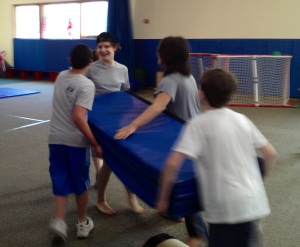Academy MetroWest uses cooperative, non-competitive physical activity as a vehicle to help kids see themselves in a more positive light and to interact better with their peers. While there’s more to any improvements in social skills and self-image than playing a bunch of games with other kids, using games that bring the focus away from kids vs. kids competition is our foundation. When kids are playing cooperative games, they feel relaxed, have fun and attain consistent success. At any given time, we’ll have 100 – 150 different activities in our active rotation. For most of them, if there is competition, it involves kids working together against adults. Over the years, some of the games that we’ve done have gone in and out of our active repertoire but some of them will always be important parts of our groups. For me, our best game is Junkyard Dogs.
Like many of our activities, Junkyard Dogs is a cooperative tag game. In these activities, we construct a base or safe area for the kids’ team. All around it, we scatter lots of stuff – usually small plastic cones (Our stock in trade – just ask anyone who’s ever been here) or foam balls. The goal for the kids’ team is to leave the safe area, collect one object at a time, and bring it back. While they do that, counselors try to tag them or hit them with a foam ball. If a kid gets tagged, rather than becoming “it” or being eliminated, he or she is frozen until another kid tags them to get them back into the game. Initially, kids may hear the message that once they’ve collected all the cones, they win. Then they become intently focused on collecting cones. If they forget to look out for their teammates, the adults are able to reduce the number of kids actively playing. Once the number of kids gets whittled down to 1 or 2, they figure out that the adults have a pretty good chance of winning but if they’re working together and saving each other, they’re going to win just about every time. The message we’re trying to emphasize is that being in a group involves more than just looking out for your own immediate self-interest. You also have to be aware of other people’s needs and then be able to take some risk or initiative to help them. The more that happens, the better the group does and the more an individual does that, the more likely it is that others will do likewise for him or her. Many of our games, including Junkyard Dogs, are variations on this theme.
In Junkyard Dogs, we create a safe zone for kids at one end of a large play space. Outside the safe zone, we scatter 4 different kinds of objects. We start, as always, with small plastic cones. Then we scatter some hula hoops, some cardboard cylinders (We get them from paper companies who use them as the cores for very large rolls of paper. Just think of the cardboard part of a roll of toilet paper big enough for the Jolly Green Giant to use) and a few folding mats all over the place.
Academy MetroWest participants working together during a game of Junkyard Dogs.
As in many of our games, the kids have to work together to collect all those objects while a counselor tries to tag them. In this game, however, there are a few complicating factors. For the 4 different types of objects that the kids have to collect, there are 4 different ways they have to do it. For the cones, it’s the same as always. Individual players leave the safe area, collect one cone at a time, and bring it back while a counselor tries to tag them. For the hula hoops, a player can leave the safe area and pick up a hoop but, by him or herself, cannot move with it. However, if another player joins in and holds on to the hula hoop simultaneously, the two of them can bring it back to the safe area together. Not only that, but as long as they’re both holding on to the hoop, they can’t be tagged by the counselor. With cylinders, it takes 3 kids working together to collect them and be safe. With mats, it takes 4. Once all the objects are collected, the kids win the game.
The part of Junkyard Dogs I like the most is that it’s impossible for kids to succeed without talking to each other or working together. Many times, kids will focus on collecting cones first but when they’re all collected, they realize that they need to join in with other kids to get the bigger stuff. It’s a great game to use as an ice breaker when working with a group for the first time. Kids on the social periphery get drawn in and little sub-groups or cliques get disregarded. It gets the kids talking to each other and working and having fun together.
For me, working as a counselor, Junkyard Dogs and games like it provide kids with an avenue in which they can have fun and success. Over time, they come to view working together with other kids as something fun and positive and they develop more confidence in their ability to make connections. Kids feel less stressed than they might in more a more competitive context and often become less defensive. This often leaves them more receptive to social feedback. Instead of hearing my feedback as just more adult nagging about their behavior, they’re more likely hear it as helpful tips coming from an ally.
For kids, it’s just a really fun game.
Recently, I thought about Junkyard Dogs after reading an article I came across in The New York Times. The author, a professor at Northeastern University, describes a study he had recently published. He writes:
“..the psychologist Piercarlo Valdesolo and I conducted an experiment ostensibly about music perception — but that actually investigated how feelings of compassion might be increased.
Our hunch was that compassion is easiest to feel when you have a sense of commonality with someone else. So we paired up participants in teams: one real participant and one confederate. First, they had to tap their hands on sensors to tones played over earphones. In some cases the tones led them to tap their hands in synchrony; in other cases, the tones led them to tap their hands in a random mismatching manner.
We next had the participants watch their tapping partner get cheated by another confederate, which resulted in the partner’s erroneously being assigned to complete a stack of onerous word problems. As our participants were leaving, they were informed by an automated message that if they desired, they could help complete some of the work assigned to their partners. If they did so, we timed how long they spent working on the task.
The results were striking: the simple act of tapping one’s hands in synchrony with another caused our participants to report feeling more similar to their partners and to have greater compassion for their plight: it increased the number of people who helped their partner by 31 percent and increased the average time spent helping from one minute to more than seven.”
Maybe this is a stretch, but after I read this article, I thought of Junkyard Dogs. I’ve played this game with some really contentious groups before. Kids who really couldn’t stand each other. Somehow, when we play Junkyard Dogs, they always seem to get it together. I’m not going to be so pompous as to say that playing this game made those kids more compassionate or led them to magically heal and become friends to the world. But, if the act of synchronous finger tapping can bring out the compassion in people, just think of the love they must feel after a game of Junkyard Dogs!
Reference:
DeSteno, David. (2012). Compassion Made Easy. New York Times. SR12. http://www.nytimes.com/2012/07/15/opinion/sunday/the-science-of-compassion.html








